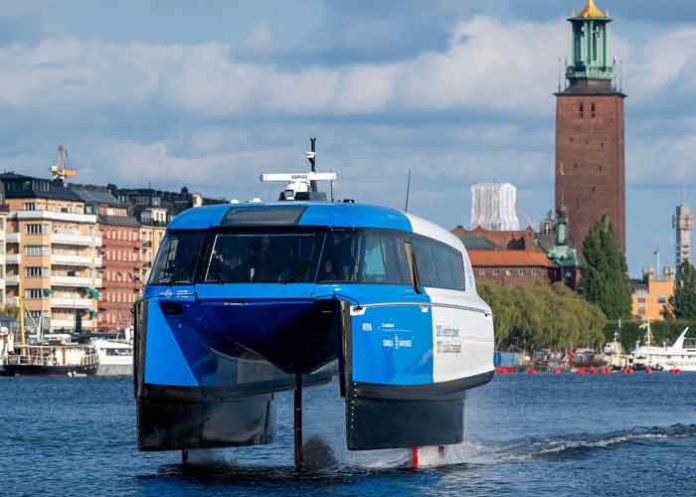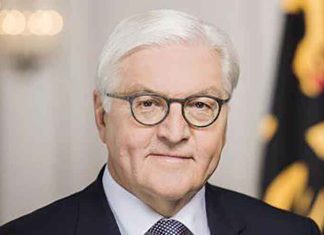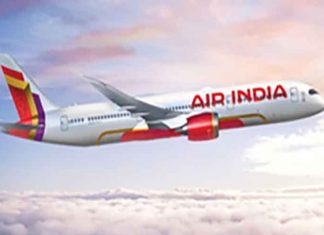Stockholm, October 29, 2024 (Yes Punjab News)
Stockholm has launched the world’s first electric hydrofoil ferry, the Candela P-12 “Nova,” marking a significant step toward sustainable waterborne public transportation. Designed to eliminate emissions while halving commute times, Nova’s debut has sparked excitement among commuters and set a precedent for eco-friendly, efficient travel across urban waterways.
A New Era of Sustainable Commuting
Departing from the Tappström suburb at 07:15 on Tuesday, Nova’s first journey covered 15 km to Stockholm’s City Hall in just over 30 minutes—almost twice as fast as traditional ferry commutes. Flying a meter above the water, the hydrofoil ferry uses advanced computer-controlled wings to lift the hull, dramatically reducing water friction and cutting energy consumption by 80% compared to conventional boats.
“This is a paradigm shift for urban transport and a revival of our waterways,” said Gustav Hasselskog, founder and CEO of Candela. Nova’s silent, efficient electric propulsion has allowed Stockholm commuters to experience a quieter, faster, and more environmentally friendly alternative to road-based transit.
Challenges in Conventional Maritime Transport
Traditional ships have evolved little over the past century and are among the least energy-efficient forms of transportation. They face significant limitations, consuming massive amounts of fuel at high speeds and generating large wakes, which restricts them within urban waters due to speed limits imposed by wake regulations. Stockholm’s public transport system includes about 70 vessels that consume more fossil fuels than all of the city’s buses and trains combined.
However, Candela’s P-12 model has effectively addressed these issues through hydrofoil technology. By “flying” above the water, Nova generates minimal wake, allowing it to operate at 25 knots within city limits—making it the fastest vessel in Stockholm’s public fleet and surpassing even diesel-powered ferries.
Hydrofoil Technology: The Key to Efficiency and Speed
Candela’s P-12 hydrofoil technology not only enables high speeds but also requires less energy due to reduced drag. Nova’s electric C-POD motors, with no mechanical transmission, make the ferry almost silent even at high speeds. Additionally, unlike conventional ferries that demand extensive dock infrastructure, Nova simply recharges at a standard fast charger, cutting down on operational costs.
As the Candela P-12 travels faster and consumes less energy, it opens up new possibilities for urban water transport. Ekerö, a rapidly growing island suburb, will benefit from Nova’s services as the ferry reduces commute times to Stockholm from an hour to just 30 minutes, bypassing rush-hour congestion.
Pilot Project and Future Impact
Nova’s introduction is part of a pilot project led by Candela in collaboration with Trafikverket and Region Stockholm (SL) to evaluate the potential of hydrofoil ferries for faster, cleaner maritime travel. The service will operate through fall 2024, pausing for the winter freeze and resuming in spring until August 2025. This project seeks to establish a sustainable model for public transport on waterways, with the goal of expanding eco-friendly ferry services across Stockholm.
“Waterways are the world’s oldest infrastructure, yet they’re underutilized in modern cities due to the costs and environmental impact of traditional vessels. With the hydrofoil ferry, we’re reviving our waterways for a more attractive, sustainable transit option,” Hasselskog added.
Global Interest in Hydrofoil Ferries
Even before Nova’s official launch, Candela’s hydrofoil technology has drawn international interest. In 2024, Candela received orders from Saudi Arabia, New Zealand, and Berlin, with more locations expected to follow suit. These orders underscore the increasing demand for greener and faster waterborne solutions in urban transport systems worldwide.
A New Era of Urban Water Transport
For the first time, the Nova electric hydrofoil ferry has proven that waterborne transport can compete with land-based travel in speed, affordability, and environmental impact. “It’s a renaissance for the world’s waterways, and it’s exciting that Stockholm is leading the way,” Hasselskog said.




































































































